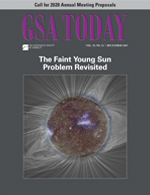Abstract View
GSA Today
Article, pp. 4-10 | Full Text | PDF
The Faint Young Sun Problem Revisited
Abstract
Earth and Mars should have been frozen worlds in their early history because of lower solar luminosity but were not, which challenges our understanding of early atmospheres and surface conditions and/or our understanding of solar evolution. This is known as the “faint young Sun problem.” One resolution to the problem is that the Sun was more massive and luminous in its youth before blowing off mass. Astrophysical studies of stellar evolution and behavior, however, including recent analysis of Kepler space-telescope data, indicate that mass loss is both insufficient and occurs too early to allow for a more luminous Sun after ca. 4 Ga. Alternatively, greenhouse gases were surprisingly effective at warming young Earth and Mars. High concentrations of CO2 with the possible addition of biogenic CH4 are likely dominant factors promoting open-water conditions on Archean Earth. Evidence of precipitation and flowing water on young Mars, including river valleys thousands of kilometers long, is more problematic. Recent studies indicate that 3–4 Ga river valleys and delta deposits in crater lakes could have been produced in <~107 years. Highly transient warm periods during times of favorable orbital parameters possibly led to brief melting under otherwise icy conditions. Seasonal melting and runoff would be more likely with ~1%–10% atmosphericH2 and CH4, perhaps derived from serpentinization of olivine in the martian crust and released from frozen ground by impacts and volcanism, and/or derived directly from volcanic outgassing. The recently recognized effectiveness of hydrogen and methane at absorbing infrared radiation in a thick CO2-dominated atmosphere, in a process known as “collision-induced absorption,” is probably essential to the solution to the faint young Sun problem for Mars.
Manuscript received 24 Feb. 2019. Revised manuscript received 30 April 2019. Manuscript accepted 13 June 2019. Posted 2 July 2019.
© The Geological Society of America, 2019. CC-BY-NC.

